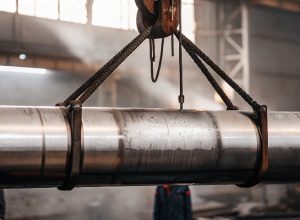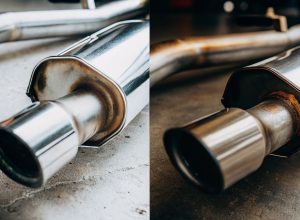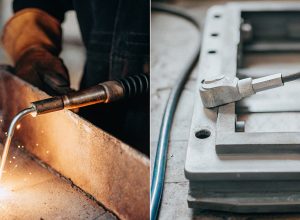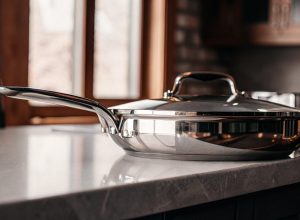Ist Titan stärker als Stahl? Titan ist ein Leichtmetall und sogar das vierthäufigste Metall in der Erdkruste. Titan hat eine höhere Zugfestigkeit, während Stahl eine höhere Druckfestigkeit aufweist. In diesem Artikel werden diese Unterschiede und andere Faktoren untersucht, um Ihnen bei der Auswahl des richtigen Metalls zu helfen.
Wichtigste Erkenntnisse
- Titan hat im Vergleich zu Stahl eine höhere Zugfestigkeit und ein besseres Verhältnis von Festigkeit zu Gewicht, wodurch es sich für gewichtssensible Anwendungen eignet.
- Stahl übertrifft Titan in Bezug auf Druckfestigkeit und Härte, was ihn zur bevorzugten Wahl für Bau- und Schwermaschinen macht, wobei seine niedrigen Kosten ein entscheidender Vorteil sind.
- Die Kosten und die Komplexität der Produktion haben einen großen Einfluss auf die Wahl des Werkstoffs. Während Titan bessere Eigenschaften bietet, wird Stahl häufig wegen seiner Erschwinglichkeit und Verfügbarkeit bevorzugt.
Einführung in Metalle
Metalle sind für die moderne Industrie von grundlegender Bedeutung und treiben den Fortschritt im Bauwesen, in der Luft- und Raumfahrt, in der Automobilindustrie und in vielen anderen Bereichen voran. Unter den zugänglichen Metallen zeichnen sich Titan und Stahl durch ihre besonderen Eigenschaften und ihre breite Verwendung aus. Titanlegierungen werden wegen ihres ausgezeichneten Verhältnisses von Festigkeit zu Gewicht, ihrer Korrosionsbeständigkeit und ihrer Leistung in rauen Umgebungen geschätzt und sind daher ideal für gewichtssensible Anwendungen.
Stahllegierungen sind für ihre Vielseitigkeit bekannt. Durch Variation der Zusammensetzung und Verarbeitung bietet Stahl eine breite Palette mechanischer Eigenschaften, darunter eine hohe Zug- und Streckgrenze und Abriebfestigkeit. Dadurch eignet sich Stahl für Anwendungen von Wolkenkratzern bis hin zu chirurgischen Instrumenten.
Die Kenntnis der mechanischen Eigenschaften von Titan und Stahl ist für die Auswahl des richtigen Metalls unerlässlich. Ganz gleich, ob Korrosionsbeständigkeit, Verhältnis von Festigkeit zu Gewicht oder Haltbarkeit im Vordergrund stehen, die Kenntnis der wichtigsten Unterschiede gewährleistet die beste Materialwahl.
Verstehen der Materialstärke
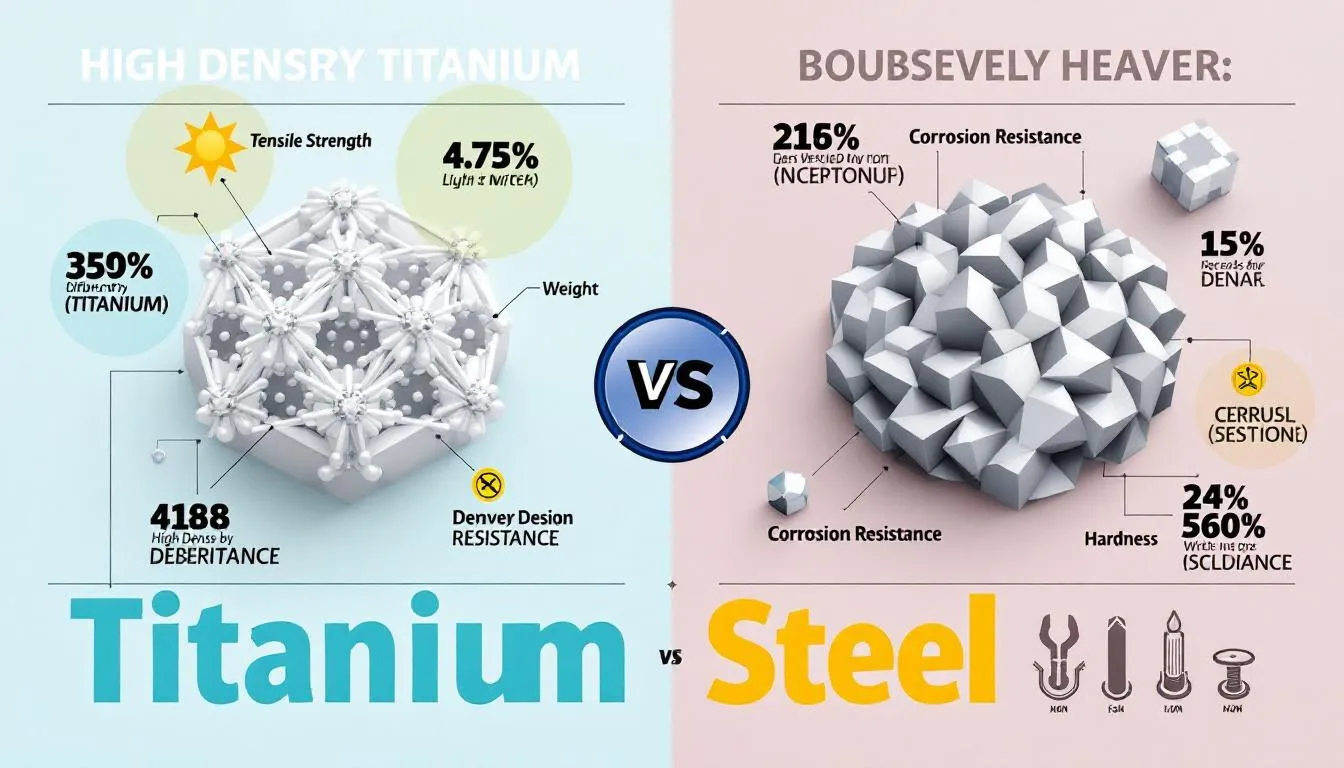
Die Materialfestigkeit bezieht sich auf die Fähigkeit eines Materials, Belastungen ohne bleibende Verformung oder Bruch standzuhalten, was für die strukturelle Integrität entscheidend ist. Die wichtigsten Festigkeitsarten beim Vergleich von Titan und Stahl sind Zug-, Druck- und Streckfestigkeit.
Die Streckgrenze ist die maximale Spannung, die ein Material bei Dehnung aushalten kann, bevor es bricht. Titan hat ein besseres Verhältnis von Festigkeit zu Gewicht als Stahl und ist daher ideal für gewichtssensible Anwendungen. Stahl wird wegen seiner Dichte, Härte und leichten Verarbeitbarkeit geschätzt.
Die Streckgrenze bezeichnet die Spannung, bei der eine dauerhafte Verformung beginnt. Die Berücksichtigung von Zugfestigkeit und Streckgrenze hilft Ingenieuren bei der Auswahl des besten Materials für ihre Anforderungen.
Vergleich der Zugfestigkeit
Titanlegierungen weisen eine beeindruckende Zugfestigkeit auf, wobei die Bruchfestigkeit von Titan etwa 63.000 psi erreicht. Im Gegensatz dazu hat Stahl eine Streckgrenze von etwa 50.000 psi, so dass Titan in dieser Hinsicht deutlich stärker ist. Einige hochfeste Stähle können jedoch die Zugfestigkeit von Titan erreichen oder sogar übertreffen, was die Überschneidung der Festigkeitswerte von Stahl und Titan verdeutlicht.
ASTM B348, Grade 5 Titan hat beispielsweise eine Zugfestigkeit von etwa 895 MPa (~130.000 psi), die deutlich höher ist als die von Baustahl. Unsere Werkstests haben gezeigt, dass Titan Grade 23, das häufig für medizinische Implantate und Teile für die Luft- und Raumfahrt verwendet wird, durchweg eine Festigkeit von über 860 MPa aufweist, was eine zuverlässige Leistung bei kritischen Anwendungen gewährleistet.
Daher ist Titan eine ausgezeichnete Wahl für Anwendungen, bei denen eine hohe Zugfestigkeit im Vordergrund steht, da Titan in diesem Zusammenhang stärker ist.
Druckfestigkeit im Vergleich
Während Titan die höchste Zugfestigkeit aufweist, übertrifft es Stahl in Bezug auf die Druckfestigkeit. Die Druckfestigkeit von Stahl liegt bei etwa 50.000 psi, die von Titan bei etwa 40.000 psi. Aufgrund dieses Unterschieds eignet sich Stahl besser für Anwendungen, bei denen die Materialien hohen Druckkräften ausgesetzt sind, wie z. B. im Bauwesen und bei schweren Maschinen.
Bei Schiffsventilgehäusen beispielsweise übertrifft Edelstahl 316 Titan Grade 2 in Bezug auf die Beständigkeit gegen Verformung unter konstantem Druck. Titan bietet jedoch nach wie vor eine überlegene Langzeit-Korrosionsbeständigkeit in Hochdruckumgebungen, was es zu einem wertvollen Werkstoff für bestimmte Anwendungen macht, bei denen sowohl Druckfestigkeit als auch Korrosionsbeständigkeit erforderlich sind.
Analyse der Streckgrenze
Die Streckgrenze ist ein entscheidender Faktor beim Vergleich von Titan und Stahl. Die Streckgrenze von Titan liegt im Durchschnitt bei 140 MPa, während unlegierte Stähle zwischen 30 und 60 psi liegen. Trotz der geringeren Streckgrenze nimmt die Festigkeit von Stahl bei hohen Temperaturen deutlich ab, was ihn unter bestimmten Bedingungen weniger zuverlässig macht.
Unser Qualitätskontrollteam führt routinemäßig Streckgrenzenprüfungen nach ISO 6892 durch. Während unlegierter Stahl bereits bei 250 MPa nachgibt, überschreiten Titanstäbe der Güteklasse 5 oft 830 MPa, bevor eine dauerhafte Verformung einsetzt. Diese Eigenschaft macht Titan zum idealen Werkstoff für flexible Strukturkomponenten, die eine hohe Elastizität und Dehnbarkeit unter Belastung erfordern.
Mechanische Eigenschaften von Titan und Stahl
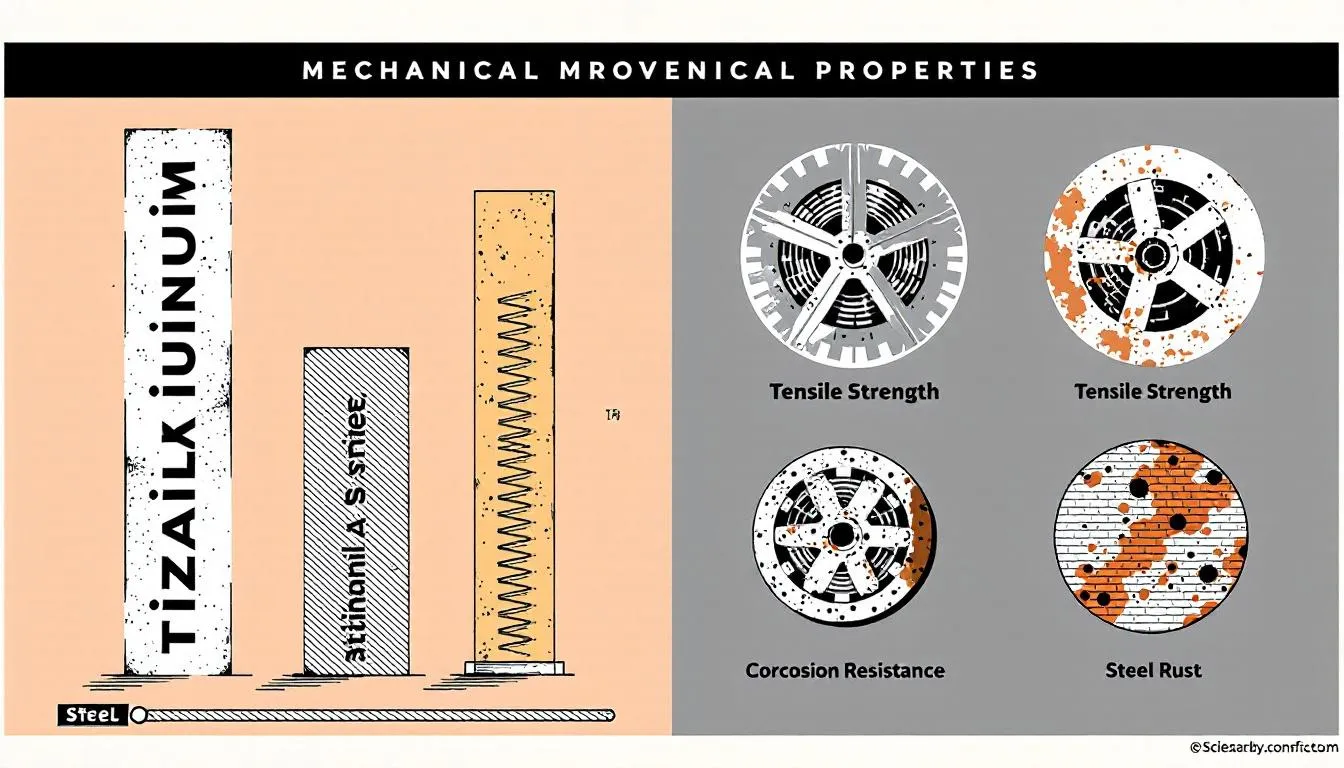
Sowohl Titan als auch Stahl sind für ihre Festigkeit bekannt, besitzen jedoch unterschiedliche mechanische Eigenschaften, die sie für verschiedene Anwendungen geeignet machen. Titan ist bekannt für seine Langlebigkeit und Korrosionsbeständigkeit, während Stahl für seine Härte und leichte Verarbeitbarkeit bekannt ist. Die Website spezifische Qualität jedes Materials und die Anwendungsanforderungen beeinflussen ihre Leistung und Eignung erheblich.
Titan ist mit einer Dichte von etwa 4,5 g/cm³ wesentlich leichter als Stahl mit 7,8 bis 8 g/cm³. Dieser Unterschied in der Dichte macht Titan zu einem vorteilhaften Werkstoff für Anwendungen, bei denen Gewichtseinsparungen von entscheidender Bedeutung sind, wie z. B. in der Luft- und Raumfahrt und in der Automobilindustrie. Die niedrigeren Kosten und die höhere Gesamtfestigkeit von Stahl machen es zu einer beliebten Wahl für das Baugewerbe und schwere Maschinen, und aufgrund dieser Vorteile wird es in vielen Branchen eingesetzt.
Die Festigkeitswerte von Titan und Stahl können sich überschneiden, wobei einige Stahlsorten stärker sind als bestimmte Titan-Grade und vice versa. Diese Überschneidung macht deutlich, wie wichtig es ist, bei der Auswahl des geeigneten Metalls für ein Projekt die spezifischen Materialeigenschaften und Anwendungsanforderungen zu berücksichtigen.
Korrosionsbeständigkeit
Titan zeichnet sich durch seine außergewöhnliche Korrosionsbeständigkeit aus folgenden Gründen aus:
- Es entwickelt eine dünne Oxidschicht, wenn es der Luft ausgesetzt wird.
- Diese undurchlässige Schicht schützt sie vor weiterer Korrosion.
- Die passive Oxidschicht macht Titan äußerst korrosionsbeständig und erhöht seine Haltbarkeit in rauen Umgebungen.
- Es ist ideal für Anwendungen, die Feuchtigkeit und Chemikalien ausgesetzt sind, und ist korrosionsbeständig.
Bei Offshore-Bohrungen werden Titan Grade 2 und 7 für die Exposition gegenüber Salzlake bevorzugt, weil:
- Sie widerstehen wirksam dem Angriff von Chloriden.
- Nichtrostender Stahl zeigt unter lang anhaltenden Seewasserbedingungen Lochfraß.
- Die natürlich gebildete TiO₂-Passivschicht des Titans bietet hervorragenden Schutz.
Elastizität und Flexibilität
Der Elastizitätsmodul von Titan beträgt 116 GPa und ist damit weniger steif und flexibler als Stahl, der einen Modul von 200 GPa hat. Diese Flexibilität kommt Anwendungen wie biomedizinischen Implantaten zugute, bei denen die Fähigkeit von Titan, sich zu biegen, ohne die strukturelle Integrität zu beeinträchtigen, wertvoll ist. So werden beispielsweise Titannägel der Güteklasse 23 in pädiatrischen Implantaten verwendet, um wachsende Knochen sicher zu versorgen.
Härte und Dauerhaftigkeit
Stahl ist in Bezug auf Härte und Haltbarkeit führend. Aufgrund seiner Härte eignet sich Stahl besser für Anwendungen, die starkem Verschleiß ausgesetzt sind. Stahl kann seine strukturelle Integrität auch unter extremen Bedingungen wie Tornados und Wirbelstürmen bewahren.
In Bergbaubetrieben:
- Verschleißfeste Stahlplatten wie AR500 sind abriebfester als Titan.
- Die geringere Härte von Titan bedeutet nicht, dass es ihm an Haltbarkeit mangelt.
- In Rohrleitungssystemen von Säureanlagen kann Titan aufgrund seiner überlegenen Korrosionsbeständigkeit 3-5 mal länger halten als Stahl.
Hochtemperaturanwendungen
Bei Hochtemperaturanwendungen wie in der Luft- und Raumfahrt, in der Energieerzeugung und bei Industriemaschinen ist die Wahl des Materials entscheidend. Titanlegierungen werden aufgrund ihres ausgezeichneten Verhältnisses von Festigkeit zu Gewicht und ihrer Korrosionsbeständigkeit bei hohen Temperaturen bevorzugt, da sie die strukturelle Integrität auch dort aufrechterhalten, wo andere Werkstoffe versagen können.
Stahllegierungen, insbesondere hochfeste Stähle, werden ebenfalls verwendet, benötigen aber oft eine zusätzliche Wärmebehandlung oder Beschichtung, um oxidationsbeständig zu sein und eine gute Hitzebeständigkeit zu erreichen. Stahl ist zwar stabil, aber schwerer und bietet nicht die gleiche Gewichtsersparnis wie Titan.
Die Entscheidung zwischen Titan und Stahl hängt von den Anforderungen der jeweiligen Anwendung ab. Titan eignet sich für gewichtsempfindliche, korrosionsanfällige Umgebungen, während Stahl kostengünstig ist und sich für große Projekte leichter herstellen lässt.
Überlegungen zu Gewicht und Dichte
Gewicht und Dichte spielen eine entscheidende Rolle bei der Materialauswahl in Branchen, in denen jedes Gramm zählt, wie z. B. in der Luft- und Raumfahrt, der Automobilindustrie und der modernen Fertigung. Titanlegierungen sind bekannt für ihre geringere Dichte im Vergleich zu Stahllegierungen, was sie zur ersten Wahl für gewichtssensible Anwendungen macht. Das überragende Verhältnis von Festigkeit zu Gewicht von Titanlegierungen bedeutet, dass Komponenten leichter sein können, ohne an Leistung einzubüßen, was sehr wünschenswert ist, wenn ein geringeres Gewicht die Effizienz und Kosteneinsparungen verbessert.
In der Luft- und Raumfahrttechnik beispielsweise führt die Umstellung von Stahl- auf Titanlegierungen zu erheblichen Gewichtseinsparungen, was die Treibstoffeffizienz und die Nutzlastkapazität erhöht. Dieser Vorteil wird durch die Korrosionsbeständigkeit von Titan noch verstärkt, die eine lange Lebensdauer in rauen Umgebungen gewährleistet.
Auch Stahllegierungen bieten Vorteile. Stahl ist zwar schwerer, aber in der Regel preiswerter und mit konventionellen CNC-Bearbeitungsverfahren leichter zu bearbeiten, was ihn praktisch macht, wenn Kosten und Herstellbarkeit eine Rolle spielen.
Zusammenfassend lässt sich sagen, dass die Wahl zwischen den beiden Legierungen von den spezifischen Anwendungsanforderungen abhängt. Wenn die Minimierung des Gewichts und die Maximierung der Korrosionsbeständigkeit von entscheidender Bedeutung sind, sind Titanlegierungen äußerst wünschenswert. Bei Projekten, bei denen niedrigere Produktionskosten und eine einfache Fertigung im Vordergrund stehen, sind Stahllegierungen nach wie vor ein starker Konkurrent.
|Überlegungen zu Gewicht und Dichte
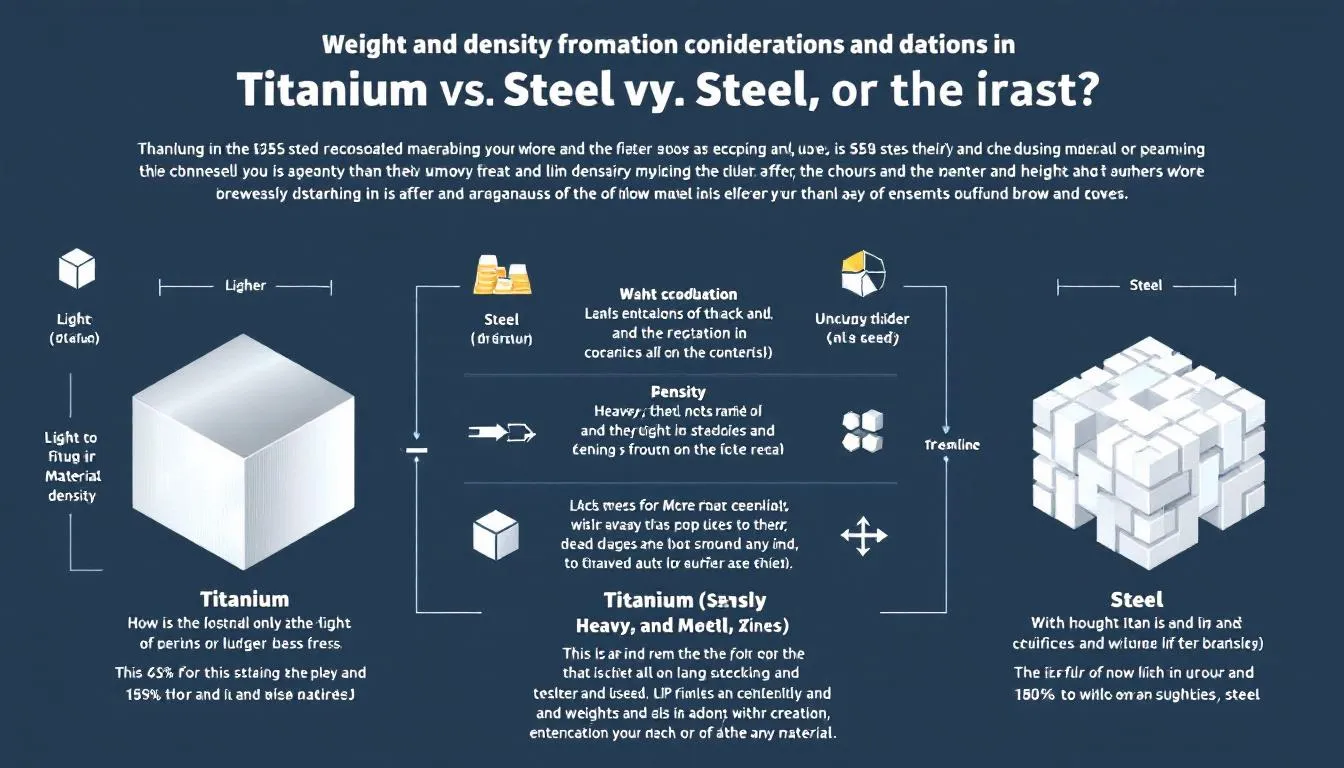
Das Gewicht und die Dichte von Materialien sind entscheidende Faktoren bei ihrer Auswahl für verschiedene Anwendungen. Betrachten Sie das Folgende:
- Titan hat eine Dichte von 4,51 g/cm³ und gehört damit zu den Leichtmetallen.
- Stahl hat eine Dichte von 7,8 bis 8 g/cm³.
- Titan ist wesentlich leichter als Stahl.
- Diese geringere Dichte macht Titan zu einer ausgezeichneten Wahl für Anwendungen, bei denen eine Gewichtsreduzierung von entscheidender Bedeutung ist, wie z. B. in der Luft- und Raumfahrt und in der Automobilindustrie.
Durch den Wechsel von Edelstahl zu Titan bei einem Drohnenprojekt konnte das Gewicht der Nutzlast um 18% reduziert und die Flugdauer um 22% verlängert werden. Dies erhöht nicht nur die Leistung, sondern verbessert auch die Treibstoffeffizienz, was Titan zu einem wertvollen Material für gewichtssensible Anwendungen macht.
Vorteile der Gewichtsreduzierung
Die geringere Dichte von Titan trägt zu einer erheblichen Gewichtsreduzierung bei Luft- und Raumfahrtkomponenten bei. Durch die Verwendung von Titan kann das Gewicht dieser Komponenten im Vergleich zu herkömmlichen Materialien um etwa 20% bis 30% reduziert werden. Diese Gewichtsreduzierung ist entscheidend für die Verbesserung der Treibstoffeffizienz und der Gesamtleistung von Luft- und Raumfahrtanwendungen.
In der Luftfahrt zählt jedes Kilogramm. Kunden aus der Luft- und Raumfahrt haben bestätigt, dass die Verwendung von Titan in Hydraulikrohren das Gewicht von Flugzeugen um bis zu 30 kg pro System reduziert hat. Diese Verringerung führt zu einer verbesserten Treibstoffeffizienz und Reichweite, was die Bedeutung von Gewichtseinsparungen in der Luft- und Raumfahrt unterstreicht.
Stabilität und Stärke
Die höhere Dichte von Stahl erhöht seine Festigkeit erheblich und sorgt für eine hervorragende Stabilität bei schweren Lasten. Dadurch eignet sich Stahl hervorragend für Anwendungen, die Stabilität erfordern, wie z. B. im Baugewerbe und bei schweren Maschinen. Bei bodengebundenen Aggregaten und Planierraupen sorgt die höhere Dichte von Stahl für minimale Vibrationen und eine bessere Drehmomentfestigkeit.
Stahl ist aufgrund seiner Gesamtdichte und -festigkeit das bevorzugte Material für Projekte, die Stabilität und Festigkeit erfordern, während Titan ein besseres Verhältnis zwischen Festigkeit und Gewicht aufweist. Diese Ausgewogenheit sorgt dafür, dass beide Metalle in verschiedenen Branchen Nischen finden und sich jeweils in unterschiedlichen Aspekten der Bautechnik auszeichnen. Stahl ist nach wie vor das stärkste Metall und die bevorzugte Wahl für viele Anwendungen.
Kosten und wirtschaftliche Rentabilität
Kosten und wirtschaftliche Tragfähigkeit sind wichtige Faktoren bei der Materialauswahl. Stahl ist im Allgemeinen erschwinglicher und weithin verfügbar als Titan, was dazu führt, dass es bei vielen wirtschaftlichen Projekten bevorzugt wird. Die hohen Kosten von Titan sind größtenteils auf die komplizierten Herstellungsverfahren und den erheblichen Ausschuss zurückzuführen.
Bei der Abwägung zwischen Stahl und Titan ist der Kostenunterschied ein wichtiger Faktor, wobei Stahl für die meisten Anwendungen eine budgetfreundliche Option darstellt.
Auf der Grundlage interner Daten zur Lieferkette wurden die Kosten für Herstellung von Titan Grad 5 ist aufgrund des Schmelzpunkts und der Komplexität der Verarbeitung 5-8 Mal höher als der Standard-Edelstahl 304. Viele Kunden verwenden Titan nur für hochwertige Komponenten, um ein Gleichgewicht zwischen Leistung und Kosten zu erreichen.
Produktionskosten
Die hohen Kosten von Titan sind für viele Projekte ein erheblicher Nachteil. Zu den Faktoren, die zu den hohen Kosten beitragen, gehören:
- Die Herstellung von Titan erfordert spezielle Anlagen
- Bei der Produktion sind hohe Temperaturen erforderlich
- Die Hauptquellen für Titan, Ilmenit und Rutil, erhöhen die Komplexität und die Kosten der Produktion.
Unternehmen entscheiden sich oft für kostengünstigere Alternativen wie Edelstahl. Trotz der überlegenen Eigenschaften von Titan in bestimmten Bereichen ist es aufgrund seiner hohen Produktionskosten für budgetabhängige Anwendungen weniger geeignet.
Marktverfügbarkeit
Die hohe Nachfrage nach Titan aufgrund seiner einzigartigen Eigenschaften schränkt die Marktverfügbarkeit weiter ein. Der Titanmarkt ist streng kontrolliert, wobei sich das weltweite Angebot an Titanschwamm stark auf China und Russland konzentriert. Wir arbeiten direkt mit zertifizierte chinesische Hüttenwerke um stabile Bestände und Qualität für die Exportkunden zu gewährleisten.
Im Gegensatz dazu ist Stahl aufgrund seiner hohen Verfügbarkeit und seines günstigen Preises in verschiedenen Anwendungen sehr beliebt, weshalb die große Mehrheit der Industrieprodukte aus Stahl hergestellt wird.
Anwendungsspezifische Auswahlmöglichkeiten
Bei der Wahl zwischen Titan und Stahl müssen sowohl das Budget als auch die erforderlichen Materialeigenschaften berücksichtigt werden. Stahllegierungen werden bei kostensensiblen Anwendungen oft bevorzugt, da sie sich für kostenorientierte Situationen eignen.
Ein Pumpenhersteller im Nahen Osten wählt Titanlaufräder für Solesysteme und verwendet Baustahl für Außengehäuse, um ein ausgewogenes Verhältnis zwischen Leistung und Kosten zu erreichen. Die Anwendung bestimmt die Materialwahl und stellt sicher, dass sowohl die Leistungs- als auch die Budgetanforderungen erfüllt werden.
Gemeinsame Anwendungen von Titan und Stahl
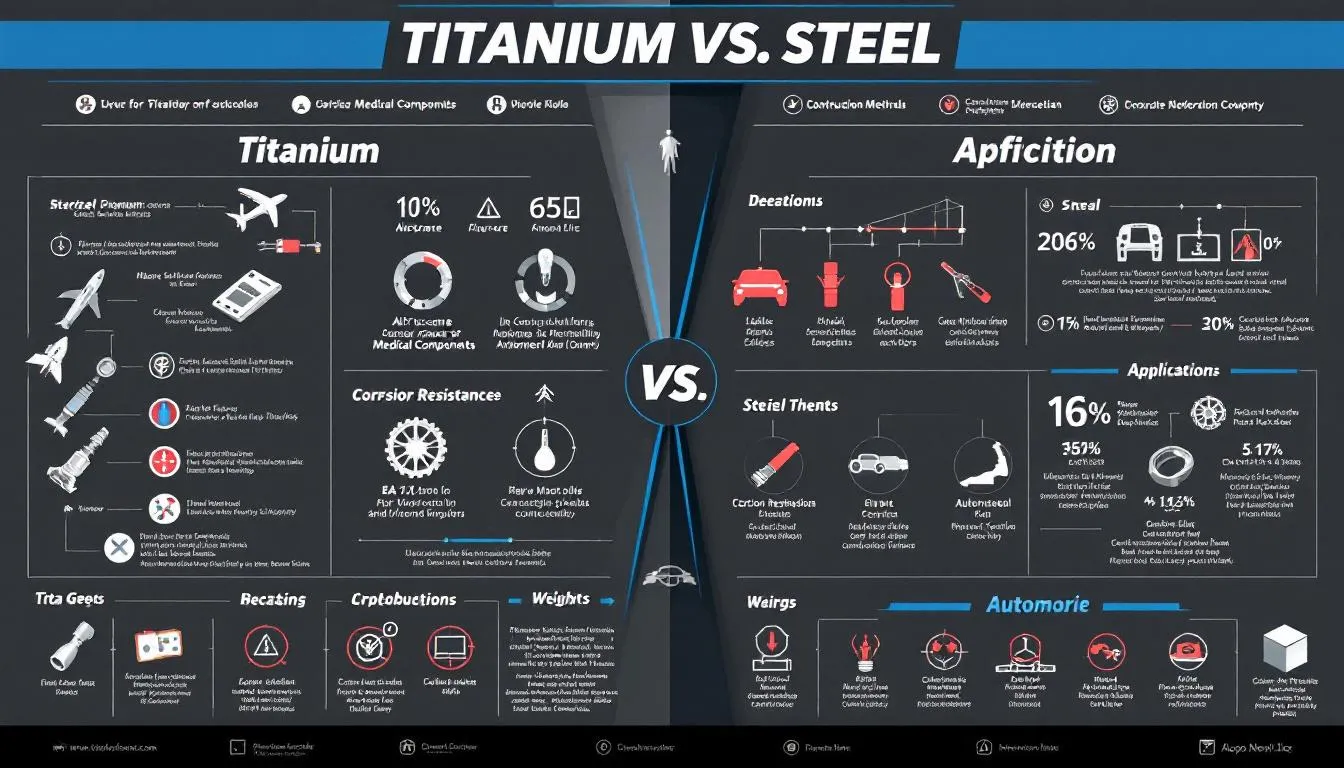
Die Anwendungen von Titan und Stahl kommen in zahlreichen Branchen zum Einsatz, die alle von den einzigartigen Eigenschaften dieser Metalle profitieren. Stahl ist aufgrund seiner Langlebigkeit und Kosteneffizienz ein wesentlicher Bestandteil von Branchen wie dem Baugewerbe, der Automobilherstellung und dem Schwermaschinenbau. Dank seiner Vielseitigkeit kann er in vielen Bereichen eingesetzt werden, von der Automobilindustrie bis zum Schwermaschinenbau, und diese Metalle werden in praktisch jeder Branche weltweit verwendet.
Titan wird in der Regel für Hochleistungsanwendungen verwendet, die starke thermische Eigenschaften und hohe Korrosionsbeständigkeit erfordern. Die leichten Eigenschaften von Titan machen es ideal für die Luft- und Raumfahrt, Automotoren und Industriemaschinen. Von der Luft- und Raumfahrt bis hin zum medizinischen Bereich werden die Festigkeit und das geringe Gewicht von Titan für kritische Anwendungen genutzt.
Luft- und Raumfahrtanwendungen
Die Dichte von Titan führt in der Luft- und Raumfahrt zu erheblichen Gewichtseinsparungen und damit zu einer besseren Treibstoffeffizienz. Aufgrund seiner hohen Festigkeit und seines geringen Gewichts wird Titan in kritischen Strukturbauteilen von Flugzeugen, einschließlich Brandwänden und Hydrauliksystemen, verwendet.
Leichte Materialien sind in diesem Bereich von entscheidender Bedeutung, um Effizienz und Leistung zu verbessern. Die hohe Korrosionsbeständigkeit und das geringe Gewicht von Titan machen es ideal für Umgebungen, in denen diese Eigenschaften von entscheidender Bedeutung sind, wie z. B. in der Luft- und Raumfahrt und in der Schifffahrt.
Medizinische Implantate
Die hohe Biokompatibilität von Titan macht es zur bevorzugten Wahl für medizinische Implantate. Seine Ungiftigkeit gewährleistet Sicherheit für Mensch und Tier, und seine Biokompatibilität verringert das Risiko von Gewebereaktionen im Vergleich zu Stahl.
Kommerziell reines Titan und Titanlegierungen werden häufig für medizinische Implantate verwendet. Wir haben Titanstangen des Grades 23 mit weniger als 0,05% Sauerstoff für orthopädische Implantate exportiert, die im Vergleich zu chirurgischem Edelstahl eine längere Lebensdauer und ein geringeres Risiko von Immunreaktionen aufweisen.
Bau- und Schwermaschinen
Stahl wird im Bauwesen aufgrund seiner Haltbarkeit und seiner Fähigkeit, extremen Bedingungen zu widerstehen, bevorzugt. Die strukturelle Integrität von Stahl bei Tornados und Wirbelstürmen macht ihn zu einem zuverlässigen Bauelement.
Stahl wird aufgrund seiner Kosteneffizienz häufig für festigkeitsorientierte Anwendungen gewählt. Seine Vielseitigkeit zeigt sich in den gängigen Anwendungen wie Bauwesen, Waffen, Schiffe und Fahrzeugrahmen.
Technische Herausforderungen und Verarbeitung
Die Bearbeitung von Titan und Stahl stellt besondere Herausforderungen an die CNC-Bearbeitung. Die geringe Wärmeleitfähigkeit von Titanlegierungen führt zu einem Hitzestau während der Bearbeitung, der den Werkzeugverschleiß erhöht. Unsere Werkstatt verwendet für die Bearbeitung von Titan Hartmetallwerkzeuge mit Kühlmittel auf Wasserbasis, um eine Überhitzung zu vermeiden.
Stahl kann bei höheren Geschwindigkeiten und geringerem Werkzeugverbrauch trocken geschnitten werden. Diese Unterschiede in den Bearbeitungsprozessen verdeutlichen die Komplexität und die Kosten, die mit der Bearbeitung von Titan und Stahl verbunden sind, wenn sie maschinell verglichen werden.
Zerspanung und Fabrikation
Titan ist aufgrund mehrerer Faktoren schwierig zu bearbeiten:
- Seine Festigkeit, geringe Elastizität und Härte.
- Seine chemische Reaktivität mit Schneidwerkzeugen bei hohen Temperaturen, was zu einer schnellen Zersetzung der Werkzeuge führt.
- Kaltverfestigung in Titanlegierungen, die einen höheren Kraftaufwand beim Schneiden erfordert und die Bearbeitung komplexer macht.
Die höhere Elastizität von Stahl erleichtert die Bearbeitung, was zu niedrigeren Produktionskosten führt.
Wärmebehandlung
Die Wärmebehandlung von Titan erhöht seine Festigkeit und Duktilität und verbessert die Leistung bei verschiedenen Hochtemperaturanwendungen. Die wichtigsten Punkte sind:
- Titan der Güteklasse 5 reagiert gut auf das Glühen bei hohen Temperaturen, insbesondere bei 700-800 °C, wodurch die Duktilität erhöht wird.
- Der Vakuum-Wärmebehandlungsofen unseres Werks sorgt für einen geringen Verschmutzungsgrad.
- Geringe Verunreinigungen sind entscheidend für Anwendungen in der Luft- und Raumfahrt oder in der Medizin.
Durch die Wärmebehandlung wird Stahl für eine Vielzahl von Eigenschaften maßgeschneidert. Die Wärmebehandlung spielt eine wichtige Rolle bei der Verbesserung der Eigenschaften von Titan und Stahl und macht sie für verschiedene Anwendungen besser geeignet.
Gießen und Umformen
Das Gießen von Titan stellt aufgrund seiner besonderen Eigenschaften eine besondere Herausforderung dar. Die hohe Dichte und der hohe Schmelzpunkt von Titan stellen beim Gießen eine große Herausforderung dar und beeinträchtigen die Effizienz und Qualität der Komponenten in verschiedenen industriellen Anwendungen. Häufig werden Titanlegierungen Spuren anderer Metalle zugesetzt, um die Härte und Verarbeitbarkeit zu verbessern.
Unserer Erfahrung nach wird Titan aufgrund seiner hohen Reaktivität nur selten gegossen. Die meisten Teile werden aus Stangen oder geschmiedeten Knüppeln geformt, wobei Isothermisches Schmieden bei 950-970°C. Dieses Verfahren gewährleistet die hohe Qualität und Leistung von Titankomponenten.
Umwelt- und Nachhaltigkeitsfaktoren
Die Umweltauswirkungen und die Nachhaltigkeit von Titan und Stahl sind wichtige Aspekte. Die Gewinnung von Titan ist komplex und energieintensiv, was zu höheren Kosten und begrenzter Verfügbarkeit führt. Das Recycling von Titan ist zwar aufgrund der strengen Anforderungen an die Sauerstoffkontrolle eine Herausforderung, trägt aber zur Verringerung der Umweltauswirkungen bei und unterstützt eine Kreislaufwirtschaft, indem es den Bedarf an einer neuen Gewinnung minimiert.
Recycling und Wiederverwendbarkeit
Das Recycling von Titan ist aufgrund des höheren Schmelzpunkts und der spezielleren Verarbeitungsanforderungen komplexer als das von Stahl. Zu den Herausforderungen beim Recycling von Titan gehört die Kontrolle von Verunreinigungen wie Sauerstoff und Eisen, die für die Aufrechterhaltung der Qualität bei Hochleistungsanwendungen entscheidend sind.
Im Gegensatz zu vielen anderen Werkstoffen kann Titan mehrfach recycelt werden, ohne seine Festigkeit zu verlieren. Die Betonung des Recyclings in der Titanindustrie kann die Ressourcen verlängern und eine Kreislaufwirtschaft fördern, die die langfristige Nachhaltigkeit verbessert.
Umweltauswirkungen der Gewinnung
Die Gewinnung von Titan führt zu erheblichen Umweltauswirkungen, einschließlich Bodenerosion. Bodenerosion und andere Umweltprobleme sind bei der Titangewinnung von zentraler Bedeutung. Diese Umweltprobleme machen deutlich, wie wichtig nachhaltige Verfahren bei der Gewinnung und Verarbeitung von Titan sind.
Da die Industrie bestrebt ist, ihren ökologischen Fußabdruck zu minimieren, wird der Fokus auf Recycling und Wiederverwendbarkeit immer wichtiger.
Langfristige Nachhaltigkeit
Die Gewinnung von Titan kann zu erheblicher Bodenerosion und hohem Energieverbrauch führen und stellt somit eine Herausforderung für die Umwelt dar. Die Haltbarkeit von Titan macht es jedoch zu einer nachhaltigen Wahl für langfristige Anwendungen, da es als elementares Erdmetall und natürlich vorkommendes Element länger als viele andere Metalle in rauen Umgebungen bestehen kann.
Die Fähigkeit von Titan, dauerhaft rauen Umgebungsbedingungen standzuhalten, gewährleistet seine langfristige Nachhaltigkeit als natürliches Metall. Diese Beständigkeit verringert die Notwendigkeit eines häufigen Austauschs und macht Titan zu einem wertvollen Material für verschiedene Anwendungen.
Die Wahl des richtigen Metalls für Ihr Projekt

Bei der Auswahl des richtigen Metalls für Ihr Projekt müssen Sie mehrere Faktoren berücksichtigen, darunter Kosten, Festigkeit und Korrosionsbeständigkeit. Stahl ist aufgrund des vorhandenen Eisens korrosionsanfällig, was zu erheblichen Wartungsproblemen führen kann. Rostfreier Stahl mildert einige dieser Probleme durch seine Rost- und Korrosionsbeständigkeit. Beim Vergleich von Stahl und Titan ist zu beachten, dass Titan ein besseres Verhältnis von Festigkeit zu Gewicht und Korrosionsbeständigkeit bietet und sich daher ideal für Hochleistungs- und Industrieanwendungen eignet, während Stahl für seine Langlebigkeit, Verschleißfestigkeit und Kosteneffizienz in einer Vielzahl von Anwendungen geschätzt wird.
In Projekten mit chemischer Belastung und engen Toleranzen, Werkzeuge Elektrische Geräte Öl, Titan ist die beste langfristige Investition. Für kostengünstige Strukturteile wird Stahl empfohlen, da er sich besser bearbeiten lässt und günstiger ist. Dieses Gleichgewicht gewährleistet, dass beide Metalle in verschiedenen Anwendungen effektiv eingesetzt werden können.
Zu berücksichtigende Schlüsselfaktoren
Bei der Wahl zwischen Titan und Stahl gibt es einige wichtige Unterschiede zu beachten:
- Gewicht
- Stärke
- Korrosionsbeständigkeit
- Preis
Es ist auch wichtig, Stahl- und Titanlegierungen zu vergleichen, da ihre unterschiedlichen Eigenschaften - wie Festigkeit und Korrosionsbeständigkeit - ihre Leistung in rauen Umgebungen beeinflussen.
Diese Faktoren beeinflussen die Eignung des Materials für verschiedene Anwendungen und helfen dabei, eine fundierte Entscheidung über andere Materialien zu treffen.
Die Berücksichtigung zusätzlicher Elemente wie die spezifischen Anforderungen des Projekts und die Umweltbedingungen sind ebenfalls von entscheidender Bedeutung. Dieser umfassende Ansatz stellt sicher, dass das ausgewählte Material alle notwendigen Kriterien für eine optimale Leistung erfüllt, einschließlich der elementaren Form und anderer Elemente.
Wann sollte man sich für Titan entscheiden?
In Situationen, in denen ein hohes Verhältnis von Festigkeit zu Gewicht wichtig ist, wird Titan häufig gegenüber Stahl bevorzugt. Es ist ideal für Anwendungen, die sowohl ein hohes Verhältnis von Festigkeit zu Gewicht als auch Korrosionsbeständigkeit erfordern, insbesondere in rauen Umgebungen.
Einige Stahllegierungen enthalten Titan, um die Korrosionsbeständigkeit und Festigkeit für anspruchsvolle Anwendungen zu erhöhen.
Aufgrund seiner einzigartigen Eigenschaften eignet sich Titan für Hochleistungsanwendungen in der Luft- und Raumfahrt, bei medizinischen Implantaten und in der Schifffahrt. Seine Fähigkeit, korrosiven Bedingungen zu widerstehen und die strukturelle Integrität unter Belastung zu bewahren, gewährleistet Zuverlässigkeit in kritischen Anwendungen.
Wann sollte man sich für Stahl entscheiden?
Stahl ist ein kosteneffizienter Werkstoff für viele Projekte, da er im Vergleich zu anderen Materialien erschwinglich ist. Er bietet eine breite Palette von Legierungen, die ihn für Anwendungen von der Konstruktion bis zur Fertigung äußerst vielseitig machen.
Trotz seiner Vorteile weist Stahl Einschränkungen auf, wie z. B. eine höhere Dichte und eine begrenzte Biokompatibilität, was seine Verwendung in speziellen Bereichen beeinträchtigt. Seine Kosteneffizienz und Vielseitigkeit sorgen jedoch dafür, dass er in allen Branchen weiterhin relevant bleibt.
Zusammenfassung
Beide Metalle bieten einzigartige Vorteile, die sich für unterschiedliche Anwendungen eignen. Für die Auswahl des richtigen Metalls ist es entscheidend, die wichtigsten Unterschiede in den Materialeigenschaften zu kennen, darunter Zugfestigkeit, Druckfestigkeit, Streckgrenze und Korrosionsbeständigkeit. Während sich Titan in gewichtssensiblen und korrosiven Umgebungen auszeichnet, bleibt Stahl eine kostengünstige, vielseitige Wahl für viele Anwendungen. Die Berücksichtigung dieser Faktoren ermöglicht fundierte Entscheidungen, die die Projektanforderungen erfüllen und den langfristigen Erfolg sicherstellen.
Häufig gestellte Fragen
Was macht Titan stärker als Stahl?
Aufgrund seines besseren Verhältnisses von Festigkeit zu Gewicht und seiner höheren Zugfestigkeit im Vergleich zu Stahl ist Titan bei bestimmten Anwendungen stärker. Daher wird es häufig in Branchen bevorzugt, die Folgendes erfordern leichte und dennoch haltbare Materialien.
Warum wird Titan für Luft- und Raumfahrtanwendungen bevorzugt?
Titan wird in der Luft- und Raumfahrt aufgrund seiner geringeren Dichte und seines hohen Festigkeits-Gewichts-Verhältnisses bevorzugt eingesetzt, was zu Gewichtseinsparungen führt, die die Treibstoffeffizienz und die Gesamtleistung verbessern.
Wie steht es um die Korrosionsbeständigkeit von Titan im Vergleich zu Stahl?
Titan weist eine bessere Korrosionsbeständigkeit als Stahl auf, da es eine dünne, undurchlässige Oxidschicht bildet, wenn es der Luft ausgesetzt wird. Diese Eigenschaft erhöht seine Haltbarkeit in anspruchsvollen Umgebungen erheblich.
Welche Auswirkungen hat die Verwendung von Titan im Vergleich zu Stahl auf die Kosten?
Die Verwendung von Titan im Vergleich zu Stahl verursacht höhere Produktionskosten aufgrund der speziellen Ausrüstung und der höheren Temperaturen, die für die Verarbeitung erforderlich sind, so dass Titan weniger geeignet ist für Anwendungen, bei denen das Budget eine Rolle spielt.
In welchen Fällen ist Stahl eine bessere Wahl als Titan?
Stahl ist die bessere Wahl als Titan, wenn Kosteneffizienz und hohe Festigkeit im Vordergrund stehen, insbesondere im Bauwesen und bei schweren Maschinen.



